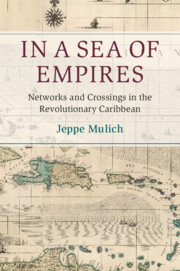Book contents
- In a Sea of Empires
- Cambridge Oceanic Histories
- In a Sea of Empires
- Copyright page
- Dedication
- Contents
- Figures
- Tables
- Acknowledgments
- 1 Introduction
- 2 Free Ports and Black Markets
- 3 Imperial Warfare, Colonial Violence
- 4 Prize Courts and Privateers
- 5 Slave Laws and Free Communities
- 6 Abolition and the Illegal Slave Trade
- Conclusion
- Bibliography
- Index
Conclusion
Published online by Cambridge University Press: 24 June 2020
- In a Sea of Empires
- Cambridge Oceanic Histories
- In a Sea of Empires
- Copyright page
- Dedication
- Contents
- Figures
- Tables
- Acknowledgments
- 1 Introduction
- 2 Free Ports and Black Markets
- 3 Imperial Warfare, Colonial Violence
- 4 Prize Courts and Privateers
- 5 Slave Laws and Free Communities
- 6 Abolition and the Illegal Slave Trade
- Conclusion
- Bibliography
- Index
Summary
The Conclusion begins with some thoughts on two historical changes that seem especially pertinent to the study at hand: the relationship between imperial authority and colonial autonomy, and the rise of British power in the nineteenth-century Atlantic world. The chapter then returns to the microregional framework of analysis presented in Chapter 1 and its specific dynamics in the context of the colonial Leeward Islands, followed by a discussion of the relevance of the concept for global imperial and maritime history more broadly, as well as for the study of nineteenth-century globalization. In exploring the usefulness of the microregional framework for analysis, the chapter discusses other inter-imperial microregions across the nineteenth century, including the Gold Coast in West Africa, Mauritius and Seychelles in the Indian Ocean, Singapore and the Strait of Melaka, the South China Coast, and Shanghai during the period of the International Settlement.
- Type
- Chapter
- Information
- In a Sea of EmpiresNetworks and Crossings in the Revolutionary Caribbean, pp. 157 - 176Publisher: Cambridge University PressPrint publication year: 2020

